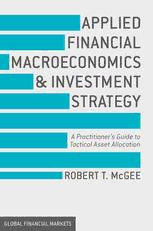
Applied Financial Macroeconomics and Investment Strategy: A Practitioner’s Guide to Tactical Asset Allocation PDF
Preview Applied Financial Macroeconomics and Investment Strategy: A Practitioner’s Guide to Tactical Asset Allocation
Global Financial Markets series Global Financial Markets is a series of practical guides to the latest financial market tools, techniques and strategies. Written for practitioners across a range of disciplines it provides comprehensive but practical coverage of key topics in finance covering strat- egy, markets, financial products, tools and techniques and their implementation. This series will appeal to a broad readership, from new entrants to experienced practitioners across the financial services industry, including areas such as institutional investment, financial derivatives, investment strategy, private banking, risk management, corporate finance and M&A, financial accounting and governance, and many more. Titles include: Erik Banks DARK POOLS, 2nd Edition Off-Exchange Liquidity in an Era of High Frequency, Program, and Algorithmic Trading Erik Banks LIQUIDITY RISK, 2nd Edition Managing Funding and Asset Risk Daniel Capocci THE COMPLETE GUIDE TO HEDGE FUNDS AND HEDGE FUND STRATEGIES Sandy Chen INTEGRATED BANK ANALYSIS AND VALUATION A Practical Guide to the ROIC Methodology Frances Cowell RISK-BASED INVESTMENT MANAGEMENT IN PRACTICE, 2nd Edition Jawwad Farid MODELS AT WORK A Practitioner’s Guide to Risk Management Guy Fraser-Sampson INTELLIGENT INVESTING A Guide to the Practical and Behavioural Aspects of Investment Strategy Michael Hünseler CREDIT PORTFOLIO MANAGEMENT A Practitioner’s Guide to the Active Management of Credit Risks Felix Lessambo THE INTERNATIONAL CORPORATE GOVERNANCE SYSTEM Audit Roles and Board Oversight Ross K. McGill US WITHHOLDING TAX Practical Implications of QI and FATCA David Murphy OTC DERIVATIVES, BILATERAL TRADING AND CENTRAL CLEARING An Introduction to Regulatory Policy, Trading Impact and Systemic Risk Gianluca Oricchio PRIVATE COMPANY VALUATION How Credit Risk Reshaped Equity Markets and Corporate Finance Valuation Tools Andrew Sutherland and Jason Court THE FRONT OFFICE MANUAL The Definitive Guide to Trading, Structuring and Sales Michael C. S. Wong and Wilson F. C. Chan (editors) INVESTING IN ASIAN OFFSHORE CURRENCY MARKETS The Shift from Dollars to Renminbi Cyril Demaria PRIVATE EQUITY FUND INVESTMENTS New Insights on Alignment of Interests, Governance, Returns and Forecasting Roger Leeds PRIVATE EQUITY INVESTING IN EMERGING MARKETS Opportunities for Value Creation Jawwad Farid AN OPTION GREEKS PRIMER Building Intuition with Delta Hedging and Monte Carlo Simulation using Excel Robert T. McGee APPLIED FINANCIAL MACROECONOMICS AND INVESTMENT STRATEGY A Practitioner’s Guide to Tactical Asset Allocation Applied Financial Macroeconomics and Investment Strategy A Practitioner’s Guide to Tactical Asset Allocation Robert T. McGee applied financial macroeconomics and investment strategy Copyright © Robert T. McGee, 2015. Softcover reprint of the hardcover 1st edition 2015 978-1-137-42389-4 All rights reserved. First published in 2015 by PALGRAVE MACMILLAN® in the United States—a division of St. Martin’s Press LLC, 175 Fifth Avenue, New York, NY 10010. Where this book is distributed in the UK, Europe and the rest of the world, this is by Palgrave Macmillan, a division of Macmillan Publishers Limited, registered in England, company number 785998, of Houndmills, Basingstoke, Hampshire RG21 6XS. Palgrave Macmillan is the global academic imprint of the above companies and has companies and representatives throughout the world. Palgrave® and Macmillan® are registered trademarks in the United States, the United Kingdom, Europe and other countries. ISBN 978-1-349-49143-8 ISBN 978-1-137-40180-9 (eBook) DOI 10.1057/9781137401809 Library of Congress Cataloging-in-Publication Data M c Gee, Robert T. Applied financial macroeconomics & investment strategy : a p ractitioner’s guide to tactical asset allocation / Robert T. McGee. pages cm Includes bibliographical references and index. ISBN 978-1-349-49143-8 1. Investments. 2. Business cycles. 3. Asset allocation. 4. Monetary policy. 5. Investment analysis. I. Title. II. Title: Applied financial macroeconomics and investment strategy. HG4521.M224 2015 332.6—dc23 2014039839 A catalogue record of the book is available from the British Library. Design by Newgen Knowledge Works (P) Ltd., Chennai, India. First edition: April 2015 10 9 8 7 6 5 4 3 2 1 To Alice and Phil TTTThhhhiiiissss ppppaaaaggggeeee iiiinnnntttteeeennnnttttiiiioooonnnnaaaallllllllyyyy lllleeeefffftttt bbbbllllaaaannnnkkkk Contents List of Exhibits ix Preface xiii Acknowledgments xvii 1 Cycles and Trends: History Does Not Repeat Itself, but It Does Rhyme 1 2 The Business Cycle 15 3 Monetary Policy 53 4 Bonds and Credit 95 5 Equities and Profits 129 6 Commodities and Tangible Assets 175 7 Investing for Long-Term Change: Challenging the Conventional Wisdom 193 8 Lessons Learned from the Financial Crisis 229 Bibliography 245 Index 247 vii TTTTThhhhhiiiiisssss pppppaaaaagggggeeeee iiiiinnnnnttttteeeeennnnntttttiiiiiooooonnnnnaaaaallllllllllyyyyy llllleeeeefffffttttt bbbbblllllaaaaannnnnkkkkk List of Exhibits 1.1 Round-Trip Back to Normal 3 1.2 What Do You See? 10 1.3 Employment Gains Are Cyclical but Anchored by Labor Force Growth 13 2.1 US Business Cycle Much Milder since World War II 17 2.2 US Business Cycle Much Milder since World War II 17 2.3 Industrial Production Declines with Recessions 25 2.4 Inverted Yield Curve Leads Recessions 26 2.5 Average Unemployment Duration Peaks after Recessions 27 2.6 Rising Backlog of Unfilled Orders Signaled Growing Economic Momentum in 2013 30 2.7 Big Variation in Housing Cycles but Permits Start Falling ahead of Recessions 34 2.8 Residential Investment Averages Just Around 5 percent of GDP but Is Very Cyclical 35 2.9 Expectations Tend to Lag Current Conditions Going into Recession 39 2.10 Inflation Pressures Pick Up with Wages. Tapering Substitutes for Initial Rate Hikes 41 2.11 Expansions End With High-Capacity Utilization 42 2.12 Credit Conditions Deteriorate before Recessions 44 2.13 Rebalancing Trade Key in New Global Business Cycle 51 3.1 Fed Policies Have Helped United States Move Out of Deflationary Danger Zone 56 3.2 United States Transitioning from Credit Bubble to Equity Bubble? 57 3.3 Unconventional Monetary Policy Kept Money Growth Stable . . . 58 3.4 . . . By Flooding Banks with Reserves . . . 59 3.5 . . . Sufficient to Offset the Collapse of the Money Multiplier 59 3.6 Hoarding of Liquidity Has Collapsed Velocity of Money 61 ix
